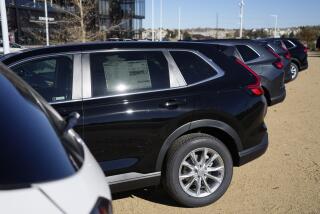Demand for smaller rental vehicles soars
- Share via
David Sikorski went to a Hertz in Austin, Texas, last month to rent a car for a business trip to Dallas. He’d booked a fuel-efficient mid-size sedan, hoping to keep expenses down on the 400-mile round trip.
What he got was a 16-mile-per-gallon Ford Explorer sport utility vehicle.
“I walked right back in and asked for something smaller,” said the computer data specialist, who eventually was given a Hyundai. “They claimed it was an upgrade, but I sure don’t want an upgrade if it means driving an SUV.”
With gasoline costing more than $4 a gallon, consumer demand for smaller rental cars is soaring. According to travel agency holding company Sabre, which owns Travelocity, bookings of compact and economy cars were up 10.2 percent and 14.3 percent, respectively, in April and May compared with 2007, while rentals in the mid-size, luxury and minivan categories declined by 1.5 percent, 24 percent and 15.3 percent.
But thanks to a major shift in the cozy relationship among U.S. carmakers and companies such as Hertz, Avis and Thrifty in recent years -- and, as a result, the way rental agencies acquire their fleets -- the availability of fuel-efficient rentals has become extremely tight.
Simply put, not enough of the nation’s roughly 1.85 million rental cars are gas savers to satisfy demand, an imbalance rental agencies cannot quickly remedy. As a result, car rental companies are struggling financially, and long-held pricing models that put more luxurious vehicles ahead of crank-window econoboxes are being turned on their head.
“Just six months ago, anybody would have taken a Chevy Trailblazer SUV in lieu of a four-cylinder Cobalt. Not now,” said Mike Kane, owner of rental car adviser Vehicle Replacement Consulting Group. “That’s a big deal. That’s 25 years of history changing.”
The changes have had a devastating effect on the industry. Although rental volume and revenue have risen in the last year, the three large publicly traded car rental companies have seen their stock plummet. Shares in premium-brand Hertz Global Holdings have declined 74 percent, while mid-range Avis Budget Group fell 82 percent and value-brand Dollar Thrifty Automotive Group dived 83 percent.
Troubles in Detroit
The woes of the car rental business are linked to those of the carmaking business.
For decades, rental companies had symbiotic relationships with General Motors Corp., Ford Motor Co. and Chrysler. The carmakers, burdened with overproduction, used rental companies as a safety valve, selling them hundreds of thousands of cars a year at deep discounts. To ensure further purchases, the carmakers bought the used cars back at guaranteed prices.
For the rental companies, buying such “program cars” was a sweet deal, allowing them to predict exactly what their acquisition and depreciation costs would be and to replace their fleets frequently, often every six months.
But in recent years, the Big Three have been cutting production as their share of the U.S. market declined, a process accelerated by a major new labor agreement last year. With fewer cars rolling off the assembly line, Detroit felt disinclined to sell them to rental companies at a discount -- and even less enthusiastic about buying them back.
Suddenly, car rental companies found themselves in the business of buying and selling cars. Not only are they paying as much as 40 percent more for some of their vehicles than before, industry consultant Neil Abrams said, but they also are forced to sell them in an uncertain market.
“It’s a real change in the fleet dynamic,” he said.
This new way of doing business puts dramatic pressures on most rental companies. (Enterprise Rent-a-Car Co., the privately held owner of National Car Rental and Alamo Rent a Car, relies less heavily on program cars and is a notable exception.) Hertz, for example, recently said it would open a retail used-car network nationwide, hoping to squeeze as much as $200 more out of each resale, according to a report from Goldman Sachs.
But the rising price of gas has radically changed used-car pricing. In May, according to Manheim Consulting, prices for used small cars rose 6 percent compared with the year-earlier period, while used SUVs and light trucks declined by 21 percent.
The rental companies now face the prospect of selling many of their bigger, gas-guzzling vehicles for far less than they expected, and with small cars representing only about a fifth of the current fleet mix, the financial implications could be grave. In the first quarter, for example, depreciation costs on used cars at Dollar Thrifty increased by 31 percent over the same period in 2007.
“If your mix is weighted to things like SUVs, that’s not an advantageous situation,” said Don Regan, executive vice president of business intelligence and fleet services at Dollar Thrifty. Part of his strategy has been to keep cars in service for an average of 14 months, compared with a previous average of nine months, a holding pattern reflected industrywide.
Manheim said the average used rental car sold in 2007 had 9 percent more miles on it than in 2006. Beyond renting older cars, the new reality means it takes longer to adjust fleet mix. It also means selling smaller, more popular cars sooner to take advantage of increases in their residual values.
It’s not ideal, the companies say, but the alternative -- selling Dodge Durangos and Lincoln Towncars at big losses to make room for new small cars that have higher acquisition costs -- is a financial blood bath.
“It’s less about having the right vehicles available for rental than figuring out which cars have the highest residual value,” Avis Budget spokesman John Barrows said.
New rental economics
For consumers such as Chris Newman, the new rental economics often mean not getting what you want. On a recent trip to Denver, the Los Angeles lawyer discovered that the rental company didn’t have a single economy car on the lot. Or any compact cars. Or mid-size. All that was left: a Ford F-150 pickup with a crew cab.
The good news was that it cost only $12 a day to rent. The bad news? It got only 15 mpg.
“I was kind of counting on getting a very small Kia or something that would get 40 miles per gallon,” he said.
Most rental companies guarantee that a rented car will be in the same class “or higher” than the one requested, a policy that allows them to bump customers up to gas guzzlers.
Although rental companies say pricing has largely stayed the same, Wall Street analysts predict a several-percent across-the-board price increase in the industry to help with the changing business model. But Steven Fitzgerald, vice president for hotel and car distribution at Sabre, said that might not be enough.
“We might see ... subcompacts renting for triple the price of SUVs,” he said.
It’s already happening. A recent survey of pricing at a Budget location at Los Angeles International Airport showed the midweek daily price for a Hyundai Accent economy car exceeded that of a Ford Explorer or a convertible Ford Mustang. Dollar and several other companies were offering SUV rentals in June for as little as $37.99 a day.
In planning purchases this year, Avis Budget said it was focusing on cars with four-cylinder engines, while Enterprise, which has 5,000 hybrids in its fleet, expects to double that next year, spokeswoman Christy Conrad said.
Despite the rising potential for frustration at the rental counter, Mark Ashley, editor of the Upgrade Travel Better blog, sees a silver lining. He says opportunistic consumers can reserve an economy car, knowing full well they’ll be driving off in some fancier ride.
“There’s a real trend of people renting aspirationally,” he said. “The opportunity is out there to try that car you always wanted to drive for cheap.”
More to Read
Sign up for The Wild
We’ll help you find the best places to hike, bike and run, as well as the perfect silent spots for meditation and yoga.
You may occasionally receive promotional content from the Los Angeles Times.






